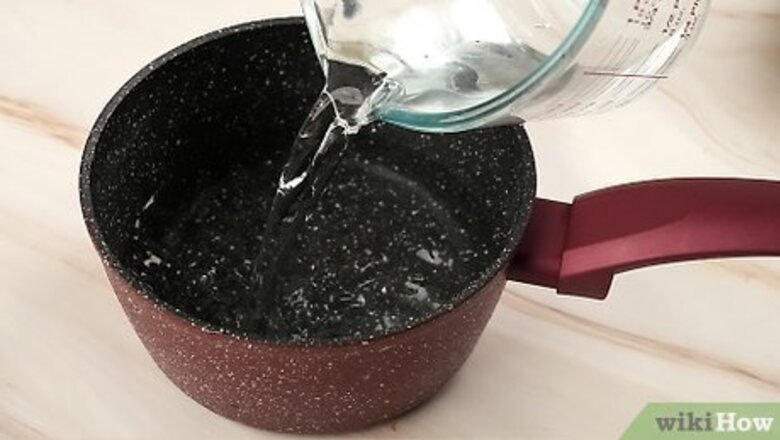
views
- For plastic bottles, take off the top and fill a pot with hot water from the faucet. Place the bottle of honey in the pot and replace the water periodically.
- For glass bottles, boil water on the stove, remove it from the heat, and set the honey container inside.
- Alternatively, fill a crock pot with water, set it to a warm temperature below 120° F (49° C), and place plastic or glass containers inside.
Decrystallizing Honey in a Plastic Bottle with Faucet Water

Fill up a pot with hot water from your faucet. If your crystallized honey is in a plastic container, boiling or microwaving water can melt the plastic. So instead, turn on your faucet to hot. Then, fill a pot with enough hot water to cover about ¾ of the honey bottle. Plastic begins to warp at temperatures above 140° F (60° C), which most homes’ facets do not heat up to. Honey crystallizes due to its low water content. About 80% of honey is made up of the sugars glucose and fructose which are dissolved in a tiny bit of water. When the water content inevitably drops over time, the glucose separates from the water and forms into crystals because it can’t dissolve. It’s completely natural for honey to crystallize and it’s still safe to eat in this form—you might even like it better than when it’s a liquid!
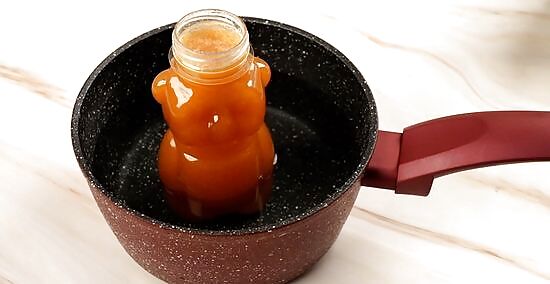
Place the uncovered plastic honey bottle upright in the water. Take the top or lid off the honey and set it in the pot, making sure the neck of the honey container peeks out from over the water. Simply pour out some water if it looks like it’ll cover the entire bottle. If water leaks into your honey bottle, it can cause your honey to ferment or even spoil. Even if you keep the top on, do not lay the plastic bottle down on its side. This can allow water to leak into the honey. If there’s only a little bit of honey in the bottle, it might float in the water. Weigh it down by placing a spoon in the bottle or laying a long, thin utensil on top, like a spatula.
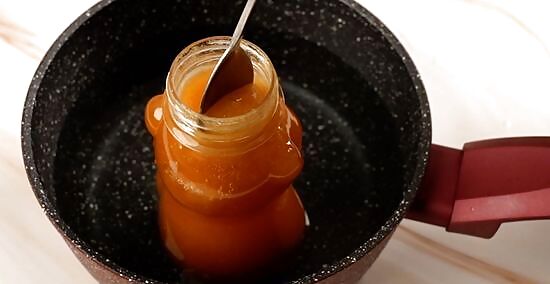
Stir the honey regularly and replace the water when it cools. Every few minutes, give the honey a stir with a spoon. This helps circulate the heat from the water through the honey and break up the crystals faster. Then, test the water temperature with your finger. When it starts to cool to room temperature, remove the honey from the pot, pour out the water, and add a fresh batch of hot water. As the honey starts to decrystallize it’ll slowly revert to its liquid state. As you stir, tilt the jar back and forth to check if the honey moves easily. Or, try to squeeze the honey into a bowl or mug. If it doesn’t come out easily, there are still crystals in it that need to be dissolved.
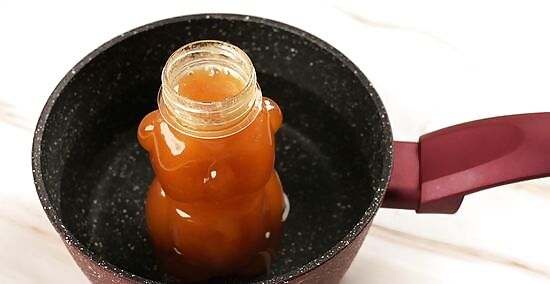
Repeat the process as needed until the honey is runny and smooth. Continue to stir the honey and tilt the container every few minutes to see if it flows easily. Then, keep checking the water with your finger and replacing it with fresh, hot water as it cools. When the crystals are completely gone, use the honey and then store it at room temperature in your kitchen. If your honey is not decrystallizing in the hot water, you may need to use boiling water following the steps below. If your honey crystallizes again, it’s okay to decrystallize it 1 or 2 more times. Repeatedly heating and softening honey can degrade its quality and make it taste less flavorful.
Soaking a Glass Jar in Boiling Water
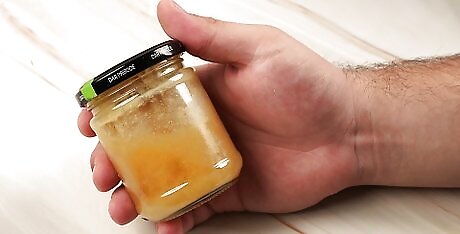
Place the honey in an uncovered glass jar if it’s in a plastic container. If your honey is stored in a plastic bottle, squeeze or spoon it into a glass container, like a mason jar or a bowl, and keep the container uncovered. If the honey is too hard and crystallized to squeeze or spoon out, run the bottle under hot water from your sink to soften it. Most plastic deforms and melts at temperatures above 140° F (60° C). So, placing a plastic bottle directly into boiling water can make the bottle unusable and contaminate the honey. Water from your sink faucet is usually lower than 140° F (60° C), so it’s not hot enough to deform the plastic.
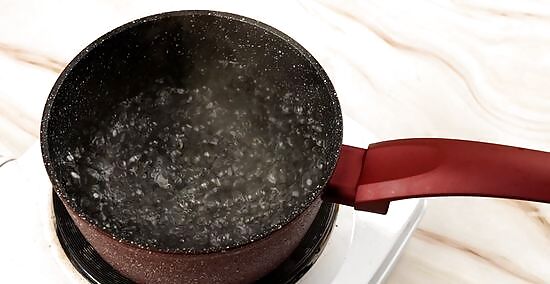
Boil a pot of water on high on the stove. Fill a pot or saucepan about halfway with water, or enough to cover about ¾ of the container the honey is in. Then, place the pot on the stove and turn the heat up to high. Let the pot sit until the water reaches a rolling boil. Alternatively, boil water in an electric kettle and pour it into a heat-safe pot or bowl.
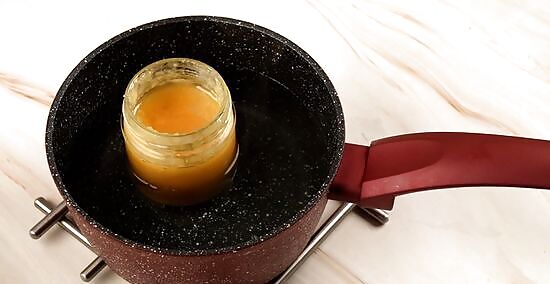
Remove the pot from the heat and place the honey inside. Turn off the stove and set the pot away from heat. Then, place the jar of honey upright in the pot so it’s about ¾ covered by the water. Keep the water level near the neck of the honey jar, but not so high that it covers the top. If necessary, pour out the water in the pot so it doesn’t cover the honey.

Stir and check the honey for crystals, replacing the water as it cools. Give the honey a stir every few minutes to circulate the heat and speed up the decrystallization. Then, take the jar out of the pot and move it side to side to check if the honey is mostly liquid. Just look for chunks of honey that don't move when the honey drips down the walls of the jar. If the water feels cool when you dip your finger into it, just take out the honey and re-boil the water. How long it takes to decrystallize the honey depends on how much you’re heating up. A small amount might take 5 minutes, while more might take upwards of 20 minutes. Wear oven mitts or gloves when you lift out the honey, as the container may be hot.

Dry off and store your honey once it’s back in liquid form. When the honey is runny and no longer contains crystals, take it out of the pot and dry off the container with a towel. Use what you need, then put the lid back on the container and set it in a cabinet that stays at room temperature. Avoid keeping the honey in an area that fluctuates between warm and cool often, like near a window sill or kitchen appliance, as this can lead to crystallization.
Using a Crock Pot to Decrystallize Honey
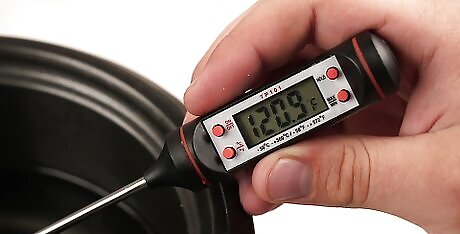
Set the crock pot on low and check its temperature. Using your crock pot works for both plastic and glass containers of honey as long as the “Warm” or “Low” setting doesn’t exceed 120° F (49° C). Higher temperatures can degrade the honey’s quality and potentially melt plastic. Just pour a little water into the slow cooker, turn it to the lowest setting, and put a thermometer in the water. Or, check your crockpot’s manual to see what the lowest temperature setting is. If the temperature is 120° F (49° C) or below, plastic and glass honey containers are safe to heat up. If it’s higher than 120° F (49° C), use a different method. Putting a plastic bottle in water that is over 140° F (60° C) can melt the plastic.

Fill your crock pot with water so it covers about ¾ of the honey jar. This decrystallization method works similarly to the other heating options, but uses a slow cooker to heat the honey more evenly. Just pour water into your crock pot until it’s enough to cover about ¾ of your honey container. Filling the crock pot so the water is level to about ¾ of the way up the honey container protects it from being contaminated with water.

Put the honey in the uncovered crock pot and check it every 30 minutes. Place the honey in the slow cooker and leave the pot uncovered. Just check on the honey about every 30 minutes, stirring it and lifting it out of the pot to see if it’s starting to run. Then, use a thermometer to check the water temperature. If it’s over 120° F (49° C), turn the crockpot off, let it cool down, then turn it back on. Note: Covering the crock pot can cause water to build up in the honey, which can cause the honey to ferment or spoil. Use oven mitts or gloves when lifting out the honey, as the container may be hot.
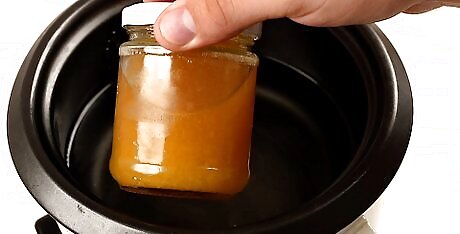
Leave the honey in the pot until it’s runny and all the crystals are gone. The time it takes to completely heat the honey depends on how much honey is in the jar and how many containers you’re heating up. Just keep checking the honey and water temperature about every 30 minutes. When the honey is smooth, runny, and there are no more crystals or chunks in the jar, take the honey out of the crock pot. If you’re decrystallizing multiple full bottles of honey, it can take up to 8 hours for the slow cooker to work.

Dry and store your honey inside at room temperature. Turn off the crock pot, take out the honey, and dry off the container with a towel. Then, simply store the honey in your kitchen pantry or cabinet that stays around room temperature. This prevents the honey from crystallizing again. Keep honey in higher cabinets in your kitchen for additional warmth, as heat rises. Don’t store the honey in a place that oscillates from warm to cool, like near a window or the oven.
Using the Microwave to Decrystallize Honey
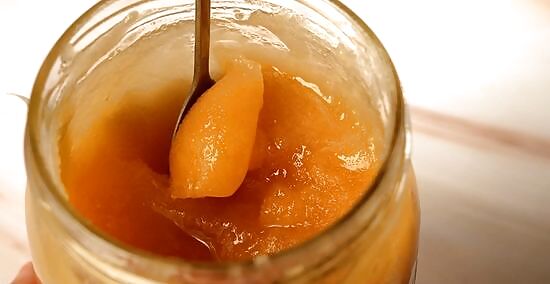
Scoop the honey in an uncovered microwave-safe dish if it’s in plastic. Microwaving honey in its plastic jar or bottle can melt the plastic, contaminating your honey and making it unusable. So, use a spoon to scoop the honey into a microwave-safe ceramic or glass jar, mug, or bowl. If the dish has a lid or cover, leave it off. If your honey is in a glass jar, simply take the lid off. Microwaving your honey is the fastest way to decrystallize it, making it a great choice if you’re in a pinch. Note: Decrystallizing honey in the microwave does not heat the honey as evenly or gently as the other methods. If you don’t microwave it slowly and carefully, the high heat can burn the honey and destroy healthy enzymes.
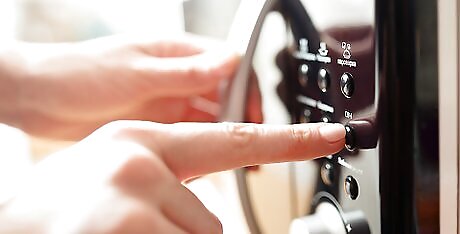
Microwave the honey on medium power for 10-20 seconds. If your microwave is set to its highest power, adjust it to a low to medium wattage of around 360-600W. Honey starts to degrade when it gets over 104° F (40° C), so this prevents it from getting too hot and losing its flavor. Then, simply heat it up in the microwave for 10 to 20 seconds.
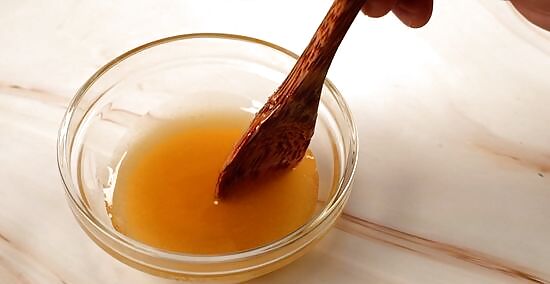
Stir the honey and heat it for 10-20 seconds until it’s decrystallized. Take the honey out of the microwave and give it a stir with a spoon. If you’re only decrystallizing a small bit of honey, it might be smooth, runny, and ready for you to use. If it is still grainy or has chunks of crystals inside, keep heating it for 10 to 20 seconds until it’s back to a liquid form. It might take 1 to 2 minutes for a larger jar of honey to fully decrystallize. If you have to microwave your honey multiple times, use a thermometer to check its temperature in between each session. If its temperature nears 104° F (40° C), let it cool before microwaving it again.
Preventing Honey from Crystallizing
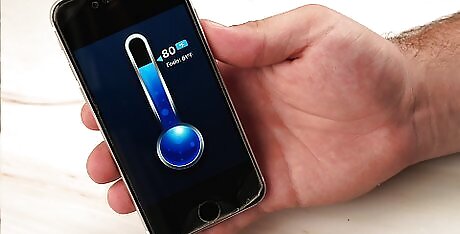
Store honey around 70-80° F (21-27° C). Honey tends to crystallize faster when it’s kept in cool temperatures around 50° F to 60° F (10-15° C). So, keep it in a room-temperature pantry or cabinet that stays on the warmer side. Make sure the spot you choose stays pretty consistent, as oscillating temperatures can lead to crystallization, too. Alternatively, store your honey somewhere it stays below 50° F (10° C) if you don’t use it often. Cold temperatures slow down crystallization but make your honey less runny, so you’ll have to warm it up to get it flowing.
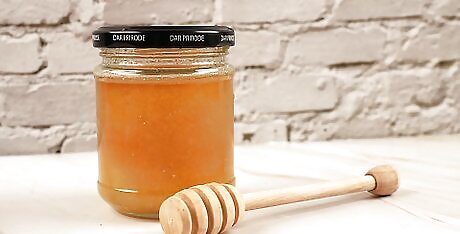
Keep your honey in glass containers. While lots of honey comes in plastic containers that are great for squeezing, honey generally keeps best in glass jars. Glass is less porous than plastic, which means it’s less affected by temperature changes in the summer and winter that can lead to crystallization. Glass is also more environmentally friendly, as you can reuse the jars for other food storage or crafts when you finish your honey.
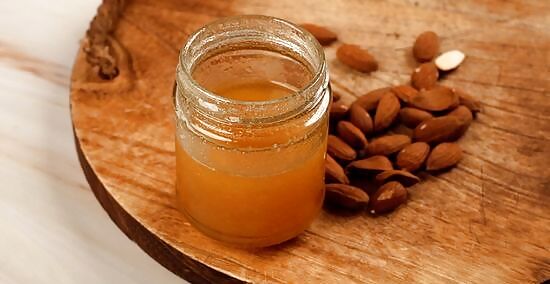
Put an air-tight lid on your honey and avoid stirring it often. Keeping the lid or top on your honey tight prevents moisture and debris from finding their way inside, which can speed up crystallization. Dust, specks of food, and water molecules give tiny, existing crystals something to grab onto and grow, while a higher moisture content can cause honey to ferment and even spoil. Stirring and agitating the honey often might also lead to crystallization, so stick to gently scooping or pouring your honey whenever you use it.
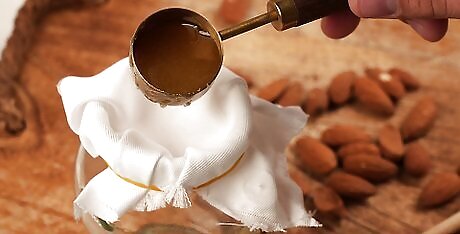
Filter raw honey to remove pollen, wax, and dust. Raw, natural honey tends to crystallize faster than processed honey because it still contains little bits of pollen and wax. These particles give the teeny, tiny existing crystals something to grow on and quickly turn your honey into a grainy substance. So, if you buy raw honey or harvest your own, strain it through a fine filter, like a cheese cloth or paint filter. Honey that has a higher concentration of fructose than glucose also tends to crystallize slower. Fructose dissolves easier in water which keeps the number of sugar crystals low.















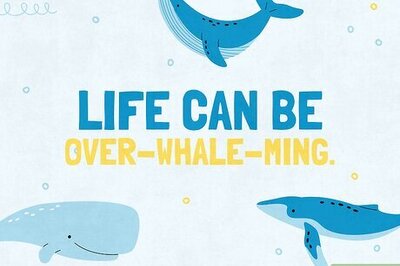
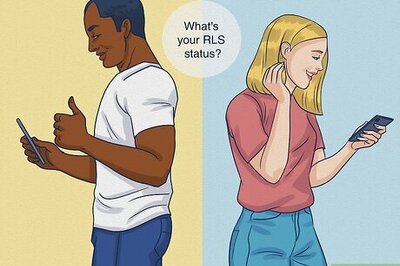
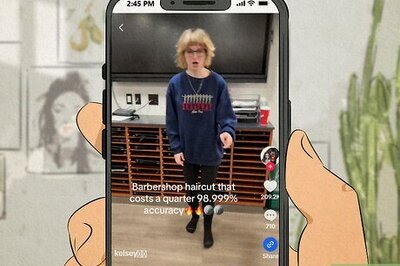
Comments
0 comment